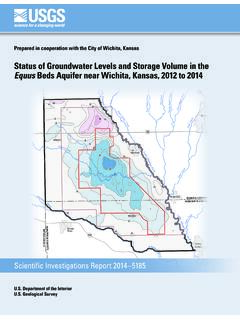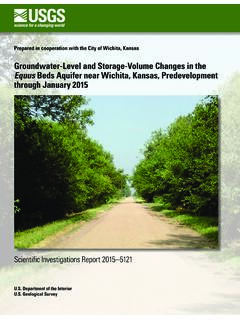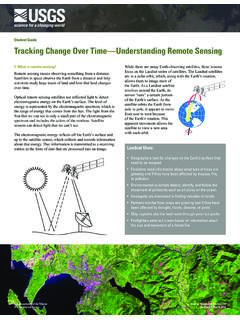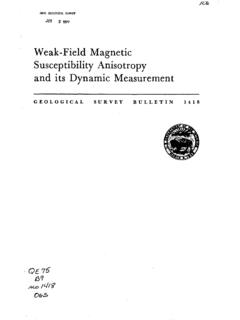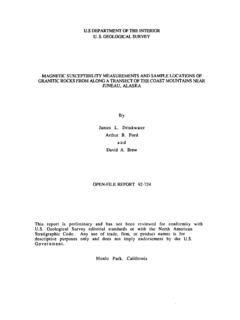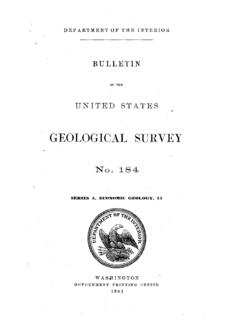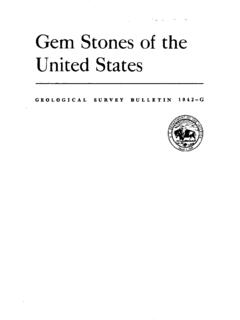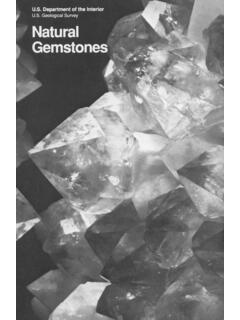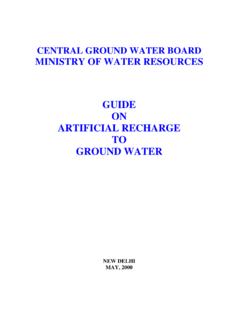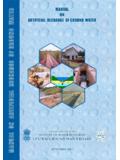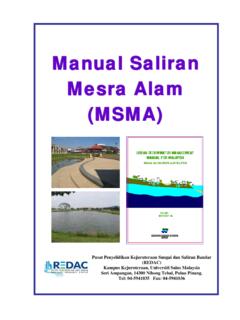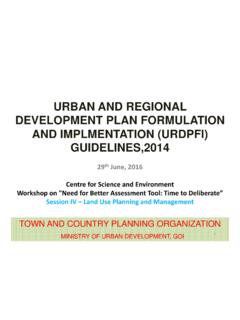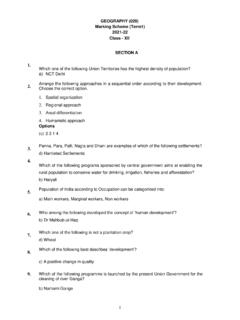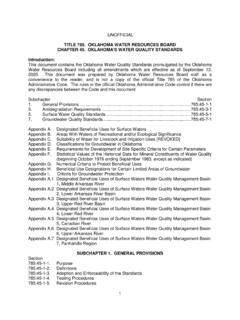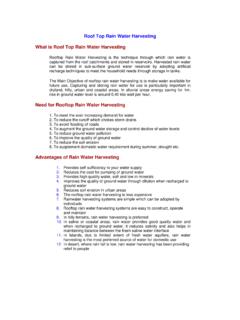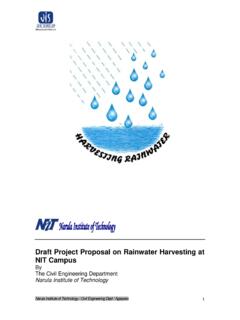Transcription of EFFECTS OF HUMAN ACTIVITIES ON THE INTERACTION OF …
1 54 HUMAN ACTIVITIES commonly affect the distri-bution, quantity, and chemical quality of water resources. The range in HUMAN ACTIVITIES that affect the INTERACTION of ground water and surface water is broad. The following discussion does not provide an exhaustive survey of all HUMAN EFFECTS but emphasizes those that are relatively widespread. To provide an indication of the extent to which humans affect the water resources of virtually all landscapes, some of the most relevant structures and features related to HUMAN ACTIVITIES are super-imposed on various parts of the conceptual land-scape (Figure 25).The EFFECTS of HUMAN ACTIVITIES on the quan-tity and quality of water resources are felt over a wide range of space and time scales. In the following discussion, short term implies time scales from hours to a few weeks or months, and long term may range from years to decades.
2 Local scale implies distances from a few feet to a few thousand feet and areas as large as a few square miles, and subregional and regional scales range from tens to thousands of square miles. The terms point source and nonpoint source with respect to discussions of contamination are used often; therefore, a brief discussion of the meaning of these terms is presented in Box OF HUMAN ACTIVITIES ON THE INTERACTION OF GROUND WATER AND SURFACE WATERA gricultural DevelopmentAgriculture has been the cause of significant modification of landscapes throughout the world. Tillage of land changes the infiltration and runoff characteristics of the land surface, which affects recharge to ground water, delivery of water and sediment to surface-water bodies, and evapotrans-piration. All of these processes either directly or indirectly affect the INTERACTION of ground water and surface water.
3 Agriculturalists are aware of the substantial negative EFFECTS of agriculture on water resources and have developed methods to alleviate some of these EFFECTS . For example, tillage prac-tices have been modified to maximize retention of water in soils and to minimize erosion of soil from the land into surface-water bodies. Two ACTIVITIES related to agriculture that are particularly relevant to the INTERACTION of ground water and surface water are irrigation and application of chemicals to 25. HUMAN ACTIVITIES and structures, as depicted by the distribution of various examples in the concep-tual landscape, affect the INTERACTION of ground water and surface water in all types of and NonpointSources of ContaminantsContaminants may be present in water or in air as a result of natural processes or through mechanisms of displacement and dispersal related to HUMAN ACTIVITIES .
4 Contaminants from point sources discharge either into ground water or surface water through an area that is small relative to the area or volume of the receiving water body. Examples of point sources include discharge from sewage-treatment plants, leakage from gasoline storage tanks, and seepage from landfills (Figure M 1).Nonpoint sources of contaminants introduce contaminants to the environment across areas that are large compared to point sources, or nonpoint sources may consist of multiple, closely spaced point sources. A nonpoint source of contamination that can be present anywhere, and affect large areas, is deposition from the atmosphere, both by precipitation (wet deposition) or by dry fallout (dry deposi-tion). Agricultural fields, in aggregate, represent large areas through which fertilizers and pesticides can be released to the differentiation between point and nonpoint sources of contamination is arbitrary to some extent and may depend in part on the scale at which a problem is considered.
5 For example, emissions from a single smokestack is a point source, but these emissions may be meaningless in a regional analysis of air pollution. However, a fairly even distribution of tens or hundreds of smokestacks might be considered as a nonpoint source. As another example, houses in suburban areas that do not have a combined sewer system have indi-vidual septic tanks. At the local scale, each septic tank may be considered as point source of contamination to shallow ground water. At the regional scale, however, the combined contamination of ground water from all the septic tanks in a suburban area may be considered a nonpoint source of contamination to a surface-water siteContaminantplumeRiverDirection ofground-water flowFigure M 1. The transport of contamination from a point source by ground water can cause contamination of surface water, as well as extensive contamination of ground SYSTEMSS urface-water irrigation systems represent some of the largest integrated engineering works undertaken by humans.
6 The number of these systems greatly increased in the western United States in the late 1840s. In addition to dams on streams, surface-water irrigation systems include (1) a complex network of canals of varying size and carrying capacity that transport water, in many cases for a considerable distance, from a surface-water source to individual fields, and (2) a drainage system to carry away water not used by plants that may be as extensive and complex as the supply system. The drainage system may include under-ground tile drains. Many irrigation systems that initially used only surface water now also use ground water. The pumped ground water commonly is used directly as irrigation water, but in some cases the water is distributed through the system of quantities of applied water range from several inches to 20 or more inches of water per year, depending on local conditions, over the entire area of crops.
7 In many irrigated areas, about 75 to 85 percent of the applied water is lost to evapotranspiration and retained in the crops (referred to as consumptive use). The remainder of the water either infiltrates through the soil zone to recharge ground water or it returns to a local surface-water body through the drainage system (referred to as irrigation return flow). The quantity of irrigation water that recharges ground water usually is large relative to recharge from precipita-tion because large irrigation systems commonly are in regions of low precipitation and low natural recharge . As a result, this large volume of artificial recharge can cause the water table to rise (see Box N), possibly reaching the land surface in some areas and waterlogging the fields. For this reason, drainage systems that maintain the level of the water table below the root zone of the crops, generally 4 to 5 feet below the land surface, are an essential component of some irrigation systems.
8 The permanent rise in the water table that is main-tained by continued recharge from irrigation return flow commonly results in an increased outflow of shallow ground water to surface-water bodies downgradient from the irrigated of Irrigation Developmenton the INTERACTION ofGround Water and Surface WaterNebraska ranks second among the States with respect to the area of irrigated acreage and the quantity of water used for irrigation. The irrigation water is derived from extensive supply systems that use both surface water and ground water (Figure N 1). Hydrologic conditions in different parts of Nebraska provide a number of examples of the broad-scale EFFECTS of irrigation development on the interactions of ground water and surface water. As would be expected, irrigation systems based on surface water are always located near streams.
9 In general, these streams are perennial and (or) have significant flow for at least part of the year. In contrast, irrigation systems based on ground water can be located nearly anywhere that has an adequate ground-water resource. Areas of significant rise and decline in ground-water levels due to irrigation systems are shown in Figure N 2. Ground-water levels rise in some areas irrigated with surface water and decline in some areas irrigated with ground water. Rises in ground-water levels near streams result in increased ground-water inflow to gaining streams or decreased flow from the stream to ground water for losing streams. In some areas, it is possible that a stream that was losing water before devel-opment of irrigation could become a gaining stream following irrigation. This effect of surface-water irrigation probably caused the rises in ground-water levels in areas F and G in south-central Nebraska (Figure N 2).
10 02040 MILESS urface-water irrigation projectEXPLANATIONF igure N 1. Nebraska is one of the most extensively irrigated States in the Nation. The irrigation water comes from both ground-water and surface-water sources. Dots are irrigation wells. (Map provided by the University of Nebraska, Conservation and Survey Division.)59 Average annual precipitation ranges from less than 15 inches in western Nebraska to more than 30 inches in eastern Nebraska. A large concentration of irrigation wells is present in area E (Figure N 2). The ground-water withdrawals by these wells caused declines in ground-water levels that could not be offset by recharge from precipitation and the presence of nearby flowing streams. In this area, the with-drawals cause decreases in ground-water discharge to the streams and (or) induce flow from the streams to shallow ground water.
